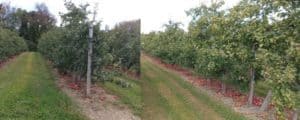Honeycrisp apples are notoriously challenging to grow, but the high prices they fetch due to their popularity with consumers provide ample reward for farmers who put in the effort. Still, growers are always looking for ways to grow this apple better with less crop loss.
For Joe Porpiglia, co-owner of Porpiglia Farm in New York with his brother, Anthony, using a nutritional program designed by Kevin Meredith, of Innovative Ag, Inc. did both.
“When he pulled in last spring and introduced himself, the first thing I said was I’m not doing any more spraying, because I already do enough,” Porpiglia says. “He laughed and said I could tank mix it, and that’s what I did.”
After testing the soil, leaf sap and fruit on Porpiglia’s farm, Meredith designed a combination program that included both KeyPlex and Agro-Liquid products to meet the trees’ specific needs. The program included a drench of Jumpstart during the prebloom period followed by periodic applications of KeyPlex Calcium-Magnesium-Boron Plus, KeyPlex 350 DP Formula, Fase 2 and N Response throughout the season.
“Everything is determined by the soil test,” Meredith says. “We check to see what nutrients we need to apply. You’re just throwing money away by adding things you don’t need. There’s a base program we use, but we modify it all the time.”
Better Color, Better Size, Less Drop
Porpiglia trialed the program on fifteen acres of his orchard: five acres each of Honeycrisp, Red Delicious and Gala. While all three varieties showed better color and size, the difference in the Honeycrisp block was significant.

Trees treated with the Keyplex-AgroLiquid combination program (left) showed significantly more vigor and healthy green leaves, with better fruit quality and color versus untreated trees (right). Photos: Kevin Meredith
“The results were unbelievable,” Porpiglia says. “We had better color, better size, less drop. The color came on better, so we were able to eliminate one pick, which is huge in our business. The foliage we had on that five acres was green right into November. Blocks right next to that had a lot of discoloration and foliage problems. In addition to saving on the labor by reducing the one pick, the yield on those trees increased by 20 percent.”
Meredith says the difference was night and day.
“The [KeyPlex treated] trees just came alive,” he says. They were green and full while the others were a little chlorotic and blotchy. I did tests on both and they were testing at about the same nutrient levels. But the Honeycrisp trees on the KeyPlex program just really woke up. We also did electronic screening on the fruit, and the incidence of bitter pit was significantly decreased as well.”
Ability to Tank Mix Saved Labor
Porpiglia said the ease of use of the KeyPlex program was important to him.
“We tank mixed it with all our cover sprays, and we had no issues with it,” he says. “There was no separate spray. That was a plus, because with Honeycrisp you already have to do 15 separate sprays with calcium.”
The results on Porpiglia’s farm were excellent, Meredith says, but were not unexpected.
“Farmers are wary – they have been sold a lot of snake oil over the years,” he says. “But KeyPlex products and programs are based on science – providing apples with the nutrients they need at the time they need them. Everything we do is based on testing – of the plant tissue and soil in the field and of our products. We know what nutrients they deliver and the products are continuously tested to meet our standards.”
For Porpiglia, the proof is in the pudding.
“With a 20-percent yield increase, better quality and being able to do three picks instead of four, I’m going to do a lot more with this product,” he says. “I started with five acres of Honeycrisp with the KeyPlex this year. This coming spring, I’m going to do all 45 acres.”
